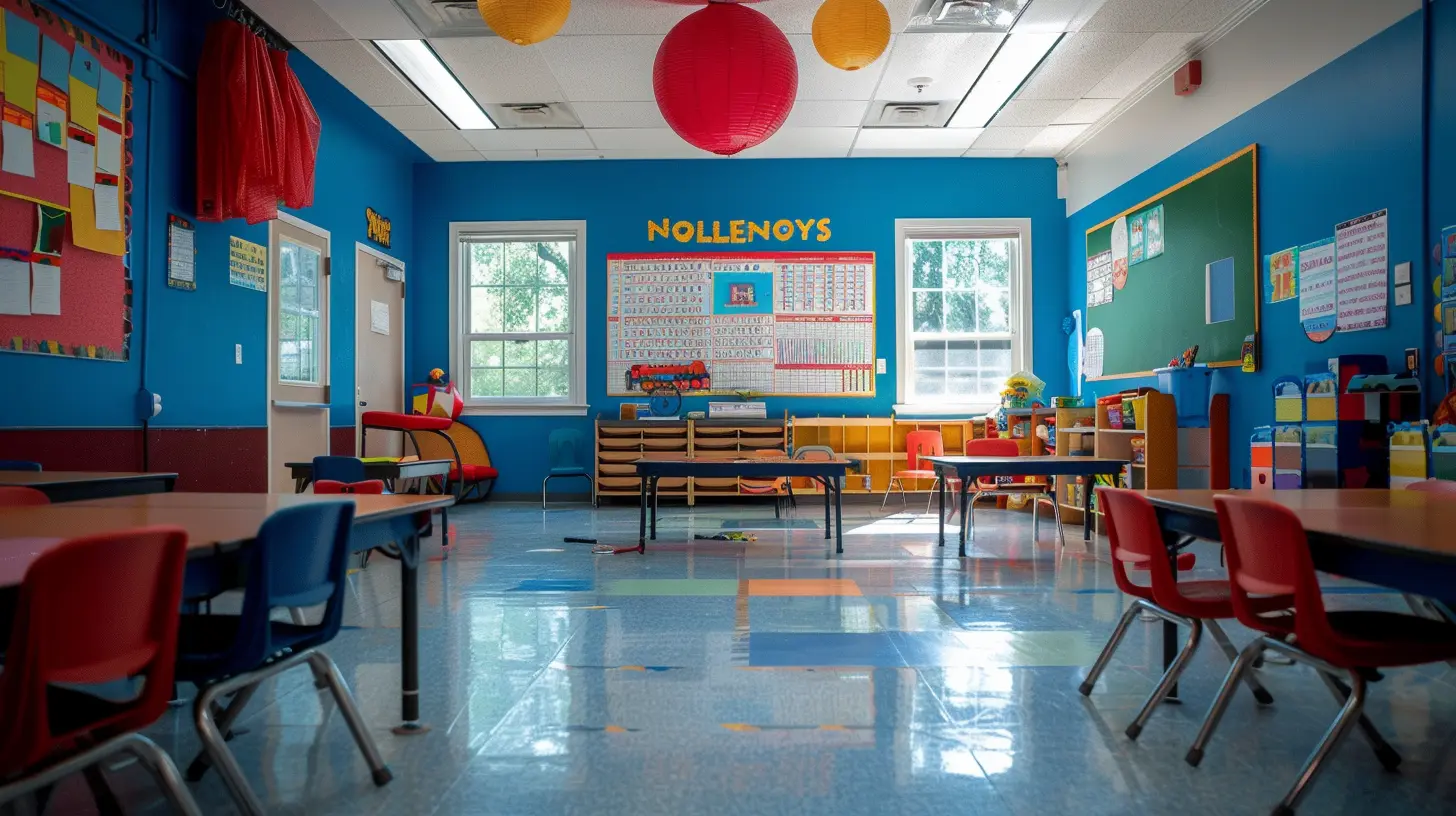How to Tailor Curriculum for a Dual Language Classroom
29 March 2025
Dual language classrooms are becoming increasingly popular as schools embrace the diverse linguistic backgrounds of students. But one of the biggest challenges teachers face in these settings is how to tailor the curriculum to meet the needs of both language learners and native speakers. The goal isn't just to teach subject matter, but to do so in a way that supports the development of academic skills in two languages. Sounds tricky, right?
Don't worry! In this article, we'll break down how to craft a dual language curriculum that’s meaningful, engaging, and effective. Whether you're already teaching in a dual-language classroom or just starting to explore the idea, these tips will help you navigate this exciting educational frontier.

What is a Dual Language Classroom?
Before diving into how to tailor a curriculum, let’s start with the basics. A dual language classroom (also known as bilingual education) is one where students are taught in two languages. In these classrooms, instruction is often split between the students' native language and a second language, commonly English. The aim is for students to become bilingual, biliterate, and bicultural.There are different models of dual-language education, but the most common are:
- 50/50 Model: Students spend half of their time learning in one language and the other half in a second language.
- 90/10 Model: Initially, 90% of instruction is in the students’ native language, then over time it gradually shifts towards a 50/50 balance.
Dual language programs are beneficial for both language learners and native English speakers. They promote cognitive flexibility, enhance cultural understanding, and of course, build strong bilingual skills. However, developing a curriculum for these classrooms requires careful planning and creativity.
Why Tailoring the Curriculum is Important
You might be thinking, "Why can't I just use a regular curriculum?" Well, here's the thing: a one-size-fits-all approach won't work in a dual language classroom. Students in these settings bring different language proficiency levels, cultural backgrounds, and learning needs to the table. To be effective, the curriculum must reflect that diversity.When you tailor the curriculum, you ensure that:
- Language learners get the support they need to develop academic and language proficiency simultaneously.
- Native speakers continue to be challenged academically while learning a new language.
- All students feel valued and included, regardless of their linguistic background.
So, how do you do it? Below, we’ll cover some strategies to help you get started.
1. Set Clear Language and Academic Goals
The first step in crafting a tailored curriculum is defining your goals. What do you want your students to achieve by the end of the year? And more importantly, how will you assess their progress in both content knowledge and language proficiency?It’s crucial to set both language goals and academic goals. For example:
- Language Goals: By the end of the school year, students should be able to write a paragraph in the second language using correct grammar and vocabulary.
- Academic Goals: By the end of the school year, students should be able to solve math word problems involving fractions.
Make sure these goals are realistic and scaffolded. Students should progress gradually, with each unit building on the previous one. Don’t expect them to master complex concepts in a second language right away. Think of it like running a marathon—you wouldn’t sprint the whole way, right? They need time and practice to get there.
2. Use a Thematic Approach
A thematic approach means organizing your curriculum around a central theme that ties different subject areas together. This is especially effective for dual-language classrooms because it gives students multiple opportunities to encounter the same vocabulary and concepts across different contexts.For example, let’s say your theme is “The Solar System.” You could:
- In science class, teach about the planets and their characteristics.
- In math, have students calculate the distances between planets.
- In social studies, explore how different cultures have historically viewed the stars and planets.
- In language arts, have students write stories about space exploration.
By revisiting the same theme in different subjects, students get more exposure to the vocabulary and concepts they need to master. It’s like putting puzzle pieces together—each piece reinforces the others until the whole picture becomes clear.
3. Incorporate Both Languages Equitably
Balancing the use of both languages in the classroom is crucial. You don’t want one language to overshadow the other. In a 50/50 model, this might mean alternating days or subjects between the two languages. In a 90/10 model, you might start the year with more instruction in the native language and gradually increase the use of the second language.A key tip: Don’t translate everything! Instead, use strategies like:
- Code-switching: This means switching between languages within a single lesson. For example, you might explain a concept in one language and give examples in the other.
- Language partners: Pair students with a partner who is stronger in the second language so they can help each other.
- Visual aids and gestures: These can bridge the language gap without relying on translation.
The goal is for students to use both languages naturally, without feeling like one is more important than the other.
4. Differentiate Instruction for Diverse Learners
In a dual-language classroom, you’ll likely have students at different proficiency levels in both languages. Differentiating instruction is essential for making sure every student gets the support they need.Here are a few ways to differentiate:
- Tiered Assignments: Offer the same content but adjust the complexity of the task based on students' language proficiency.
- Flexible Grouping: Group students by language ability for some activities and by interest or ability level for others.
- Choice Boards: Give students options for how they can demonstrate their understanding. For example, some students might prefer to write a report, while others might want to create a visual presentation.
Differentiation ensures that all students are challenged but not overwhelmed.
5. Leverage Culturally Responsive Teaching
Dual-language classrooms are often culturally diverse, so it’s important to use culturally responsive teaching strategies. This means integrating students' cultures and experiences into the curriculum, making the learning environment more inclusive and engaging for everyone.For example:
- Use multicultural texts in language arts that reflect the cultures of your students.
- Incorporate cultural traditions and holidays in lessons or classroom activities.
- Encourage students to share their own experiences and knowledge from their cultural backgrounds.
When students see themselves reflected in the curriculum, they’re more likely to feel motivated and connected to the learning material.
6. Use Scaffolding Techniques
Scaffolding is a key strategy in any classroom, but it’s especially important in dual-language settings where language learners might struggle with both the content and the language. Think of scaffolding as the training wheels on a bike—it provides temporary support until the student is ready to ride on their own.Some scaffolding techniques you can use include:
- Sentence frames: Provide sentence starters or structures to help students articulate their thoughts in the second language.
- Visual organizers: Use diagrams, charts, and mind maps to help students organize their ideas.
- Chunking information: Break lessons into smaller, manageable pieces, and check for understanding before moving on.
By gradually removing scaffolds as students gain confidence, you’ll help them become more independent learners.
7. Assess in Both Languages
Assessment in a dual-language classroom is tricky because you’re evaluating both content knowledge and language proficiency. It’s important to assess students in both languages, but you need to be clear about what you’re assessing.For example, if you’re assessing students' understanding of a science concept, don’t penalize them for language errors in their second language. On the flip side, if you’re assessing language skills, focus on grammar, vocabulary, and fluency rather than the content.
Some assessment strategies include:
- Formative assessments: Use quizzes, exit tickets, and informal observations to monitor students’ progress in both languages.
- Performance-based assessments: Have students complete projects or presentations that allow them to demonstrate understanding in creative ways.
- Self-assessments: Encourage students to reflect on their own language and academic progress.
The goal is to get a full picture of what students know and can do in both languages.
Conclusion
Tailoring a curriculum for a dual-language classroom is no easy task, but it’s incredibly rewarding. By setting clear goals, using a thematic approach, balancing both languages, differentiating instruction, and scaffolding lessons, you’ll create a learning environment where all students can thrive. Remember, your goal is not just academic success, but also fostering bilingualism and biliteracy in a way that values students' diverse backgrounds. With thoughtful planning and a flexible mindset, you’ll be well on your way to creating a dynamic and inclusive classroom.all images in this post were generated using AI tools
Category:
Bilingual EducationAuthor:

Monica O`Neal
Discussion
rate this article
7 comments
Vanya Cruz
Tailoring a curriculum for a dual language classroom is like mixing a gourmet recipe—balance the flavors, sprinkle in some culture, and watch the learning feast! Bon appétit, educators!
May 8, 2025 at 3:10 AM

Monica O`Neal
Thank you for that delightful analogy! Striking the right balance truly enhances the learning experience in dual language classrooms. Bon appétit indeed!
Barbara Mitchell
Why did the bilingual tomato turn red? Because it saw the curriculum getting tailored for a dual language classroom! Just like those juicy veggies, each lesson should be ripe with creativity. Let’s sprinkle in some fun to make learning in two languages a delicious experience!
April 14, 2025 at 12:12 PM

Monica O`Neal
Great analogy! Infusing creativity and fun into a dual language curriculum truly makes learning more enriching and enjoyable for students. Let's keep those ideas juicy!
Violet Acevedo
Tailoring curriculum for a dual language classroom requires a nuanced understanding of both languages and cultures. Integrating content that reflects students' linguistic backgrounds fosters inclusivity and motivation. Emphasizing collaborative learning and thematic units not only enhances language skills but also enriches cultural appreciation, benefiting all learners.
April 7, 2025 at 10:18 AM

Monica O`Neal
Thank you for emphasizing the importance of cultural and linguistic integration in a dual language classroom. Your insights on collaborative learning and thematic units are vital for fostering an inclusive environment and enhancing student engagement!
Roxanne McFarlane
Great insights! Tailoring curriculum effectively enhances learning and supports bilingual students' success.
April 7, 2025 at 4:34 AM

Monica O`Neal
Thank you! I'm glad you found the insights valuable for supporting bilingual students.
Rhiannon Riggs
Exciting insights for enriching dual language learning experiences!
April 2, 2025 at 3:12 AM

Monica O`Neal
Thank you! I'm glad you found the insights valuable for enhancing dual language learning experiences.
Emmeline Bell
Thank you for this insightful article! Tailoring curriculum for dual language classrooms is essential for fostering inclusivity and supporting diverse learners. I appreciate the practical strategies shared here!
April 1, 2025 at 12:56 PM

Monica O`Neal
Thank you for your thoughtful comment! I'm glad you found the strategies helpful for promoting inclusivity in dual language classrooms.
Rocco McDowell
Great insights! Essential for effective teaching!
March 29, 2025 at 7:54 PM

Monica O`Neal
Thank you! I'm glad you found the insights valuable for effective teaching.
MORE POSTS

The Importance of Lifelong Learning for Professional Success

Nurturing Creative Problem Solving in Early Childhood Education

The Impact of Artificial Intelligence on Digital Literacy Education

Balancing Local Control and Federal Oversight in Education

How to Teach Students to Synthesize Information From Texts

What Colleges Are Really Looking for in Applicants